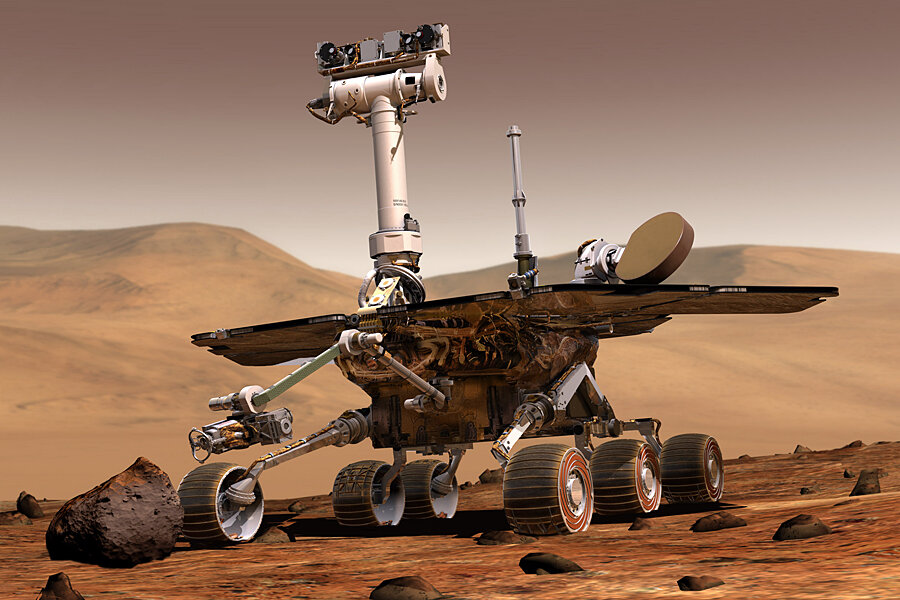Half a world apart, Mars rover 'cousins' find signs of water friendly to life
A hemisphere away from NASA's Mars rover Curiosity, the rover's older cousin Opportunity has uncovered evidence for an ancient environment potentially hospitable for life. The evidence appears in rock formations significantly older than those Curiosity is exploring.
The evidence comes in the form of clays whose composition testifies to the presence of water in conditions that were neither too acidic nor too salty for microbes to endure.
The find contrasts with mineral-based evidence for water Opportunity has uncovered elsewhere on the plain. These earlier observations suggested that any watery environment would have been so acidic and salty that even the toughest microbes known to science would have had a hard time surviving there.
Not so for rock outcroppings on Matijevic Hill, a mound that sits on Cape York, a portion of the rim encircling Endeavour Crater.
"If I were there back when this material was being emplaced and altered and had my summer house, this is where I would drill to get good drinking water," says Ray Arvidson, a planetary scientist at Washington University in St. Louis and the deputy lead investigator for the Mars Exploration Rovers Spirit and Opportunity.
The new results from Opportunity's exploration of Endeavour Crater were unveiled Thursday, two days before the 10th anniversary of the rover's touchdown on Meridiani Planum, a broad plain near Mars' equator.
The results also come nearly two months after Curiosity's science team unveiled several lines of evidence suggesting that early in Mars' history, water flowed into Gale Crater from its rim. The flow built a network of streams, groundwater deposits, and even formed a lake at the foot of the crater's central summit, Mt. Sharp. This environment could have lasted for millions of years, according to John Grotzinger, a geologist at the California Institute of Technology in Pasadena and Curiosity's project scientist.
Here, too, the mineral evidence indicated that the environment was not too acidic and not too salty, but fell within a benign range that would have supported microbial life, if it existed.
But the rocks analyzed at Gale Crater are about 3.7 billion years old or less. This falls within a period known as the Hesperian era, when the planet's climate is thought to have begun its transition from warm and wet to the chilled, dry climate researchers see today.
The formations at Endeavour, however, reveal conditions somewhere between 4.1 billion and 3.7 billion years ago, a time span known as the Noachian era.
The telltale formations included thin-layered, fine-grained rock through which water would have moved to slightly alter the clay composition, as well as other rocks with larger crevices through which water would have flowed more freely. In turn, these were capped by rocks that clearly formed when an impactor punched into the surface to form the nearly 14-mile-wide crater.
Since the crater itself has been roughly dated to the planet's Noachian period, the rocks the impact's ejecta covered clearly are older, notes Dr. Arvidson, who is the lead author on a formal research paper describing the results. The paper is set for publication Friday in the journal Science.
"The punchline is that mild water conditions extended in two different places over a long period of geologic time two different areas," he says.
Unfortunately, the blanket of ejected material overlying the exposed rocks Arvidson and his team were able to study is sufficiently extensive that it's hard to figure out if the rocks of interest represent a lake bed, a deposit of volcanic ash through which water percolated, or some other feature.
At Gale Crater, by contrast, researchers could clearly see in images taken from orbit an alluvial fan spreading down and out from the crater's northern rim. Such features testify to sediment-laden water flowing down slope.
Hopes are high that Opportunity's next destination could shed additional light on potential habitability and perhaps, as at Gale Crater, the larger environmental context in which the clays formed.
Next stop: Cape Tribulation, which sits atop Murray Ridge, a feature Opportunity is climbing now. Data from the Mars Reconnaissance Orbiter had tipped the team off to the presence of clays at Matijevic Hill, "but the signal was really weak," said Steven Squyers, a planetary scientist at Cornell University in Ithaca, N.Y., and the mission's lead scientist.
At Cape Tribulation, "that's where the mother lode appears to be," he said at a press briefing Thursday. The clays appear to be present over a wider area and at much higher concentrations than at Cape York's Matijevic Hill.
"What we're going to see, we don't know," he said.
Before the team moves much farther, however, it is trying to unravel the mystery of the "jelly doughnut," a rock that at some point within a four-day period suddenly appeared near the rover.
Although the rock's sudden arrival is strange, "we don't think anything particularly exotic is happening here," Squyers said. The leading explanation: In performing a kind of pirouette maneuver a bit farther uphill, a balky wheel dragged across a small rock outcropping "and tiddly winked it out of the ground," Squyers said. The team has tried to hunt for the divot the rock once filled, but to no avail so far. It may be blocked from view by the rover's solar panels.
If the wheel indeed flipped it, the team may be looking at a part of the rock protected from the Martian atmosphere for billions of years.
What is clear is that the rock, encrusted in white material with a dark-red center, is unlike any rock the team has analyzed in the last 10 years. It hosts a high concentration of sulphates and manganese, and higher concentrations of magnesium than any other Martian the team has analyzed.







